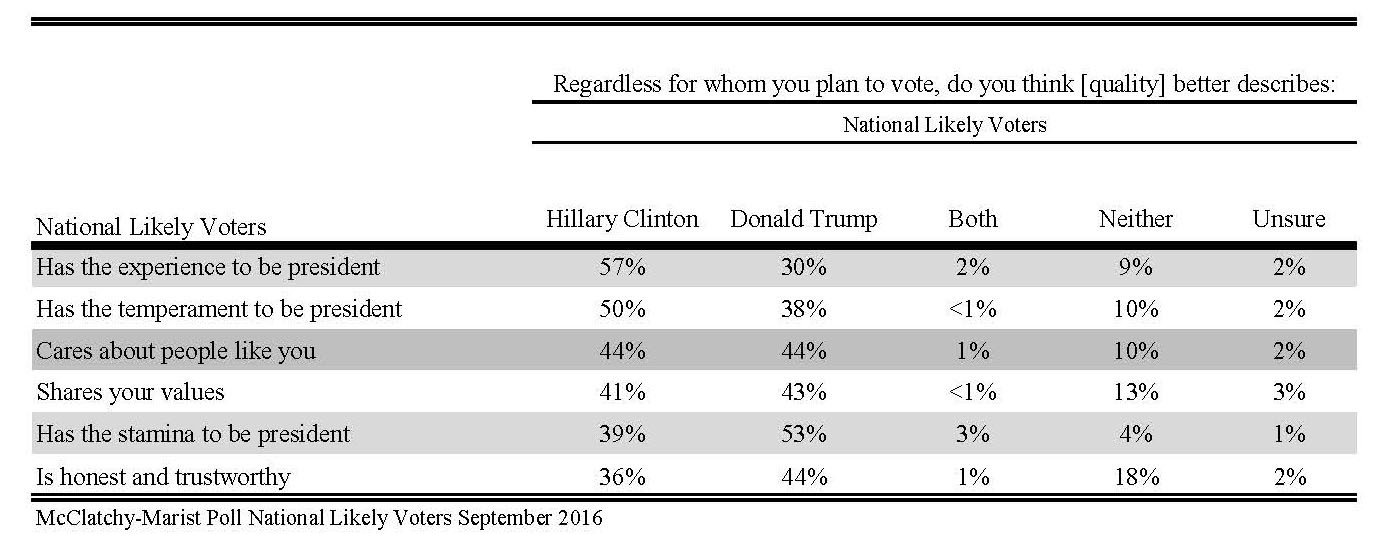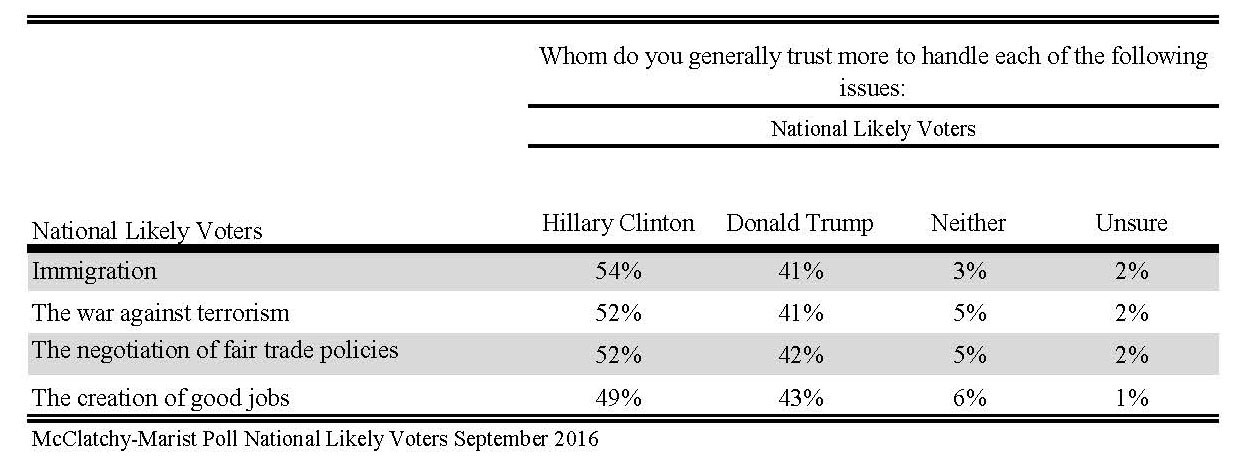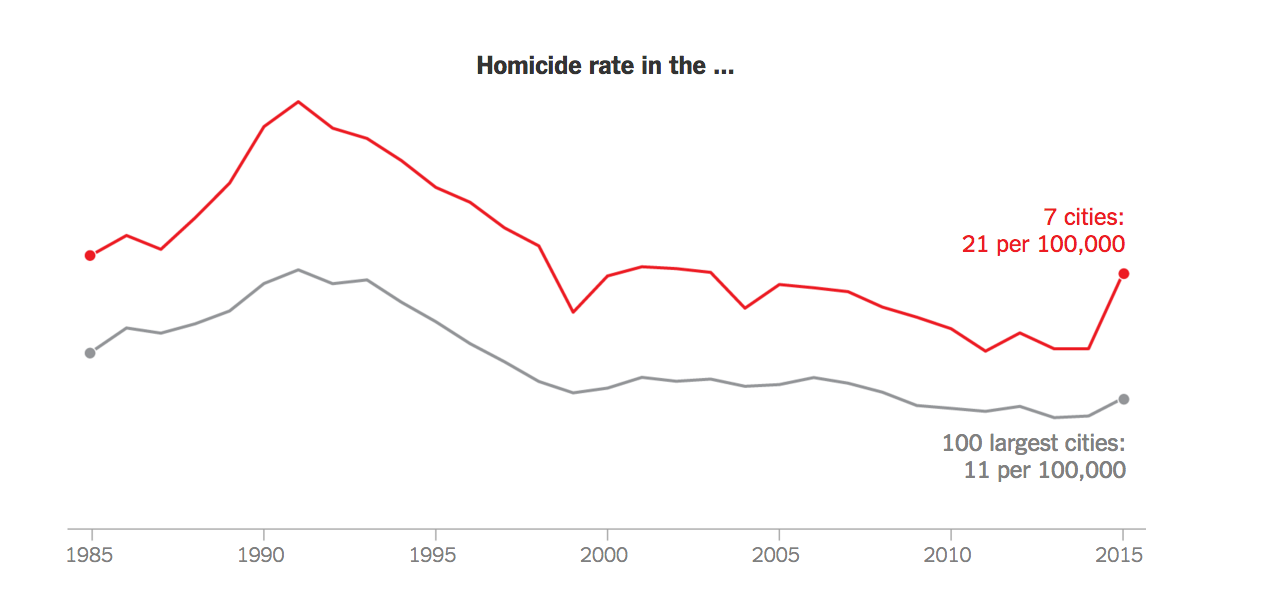From childcare to criminal justice, we’ve got you covered.
(Photo: Spencer Platt/Getty Images; Taylor Le/Pacific Standard)
Temperament and Trustworthiness
The main question people had been asking ahead of the first presidential debate between Donald Trump and Hillary Clinton: Which Trump would show up?
Going in, we didn’t entirely know, and Trump’s people — bless their hearts — probably didn’t either. (The Associated Press reported that “some Trump aides are more concerned about Trump’s disposition on the debate stage than his command of the issues.” What a scoop!) In a handful of opening exchanges, Trump seemed underprepared, wandering off-script and into a version of his stump that didn’t look terribly good on split-screen, though he worked to modulate his normally boisterous stage presence.
And Trump needs — badly — to convince voters that he can be semi-dignified, even in attack. Clinton, meanwhile, has a trust gap of her own to close.
A McClatchy/Marist poll of likely voters released on September 23 outlines the challenges facing each candidate. These include “intangibles,” such as temperament and stamina:
- 50 percent of likely voters said Clinton has the temperament to be president, compared to just 38 percent for Trump.
- 53 percent of likely voters said Trump has the stamina to be president, compared to just 39 percent for Clinton.
- 44 percent of likely voters say Trump is “honest and trustworthy,” compared to just 36 percent for Clinton.

The poll also measured trust gaps on specific policies:
- 52 percent of likely voters said Clinton is more trustworthy on terror, compared to 41 percent for Trump.
- 54 percent of likely voters said Clinton is more trustworthy on immigration, compared to 41 percent for Trump.

There’s a fascinating difference between the first chart and the second: Voters tend to consider Clinton “untrustworthy” in the abstract, but when it comes to immigration, jobs, trade, and terror — all signature Trump issues — voters trust Clinton by significant margins. —Ted Scheinman
Childcare
The conversation at the presidential debate kicked off with childcare — one area where both candidates actually have fully fleshed policy agendas. Clinton’s plan relies on a combination of tax credits and government investments in childcare programs and would cap childcare spending at 10 percent of a family’s income, whereas Trump’s plan relies exclusively on tax deductions and credits to make childcare more affordable.
Childcare is currently undergoing an affordability and a quality crisis. Only South Dakota and Wyoming have childcare that costs 10 percent or less of a family’s income, according to a report from the Economic Policy Institute, a liberal think tank.
And childcare is hugely influential on a kid’s development.As Dwyer Gunnwrote for Pacific Standard in May:
Back in the 1990s, a team of researchers tracked second-graders who had attended center-based childcare in their early years. In a report summarizing the study, the researchers found that “[c]hildren who attended higher quality child care centers performed better on measures of both cognitive skills (e.g., math and language abilities) and social skills (e.g., interactions with peers, problem behaviors) in child care and through the transition into school.”
With that in mind, here are a few facts underscoring the differences between Trump’s and Clinton’s plans:
- Clinton’s plan is targeted primarily at lower- and middle-income earners; analysts say that, under Trump’s plan, wealthier Americans would see the biggest gains.
- Clinton’s plan calls for increased funding for public childcare centers, as well as childcare tax credits for low- and middle-income families, and caps childcare spending at 10 percent of a family’s income. Clinton’s plan also includes a number of proposals aimed at increasing the pay and credentials of childcare providers.
- Trump, by contrast, has proposed making childcare costs tax-deductible for those making up to $250,000 (for individuals) or $500,000 (for couples filing jointly). Trump’s plan also calls for an expanded childcare tax credit for low-income families through the Earned Income Tax Credit (up to $1,200). Neither candidate has released detailed plans for how they intend to pay for their proposals.
- When it comes to maternity leave, Trump proposes a required six-week maternity leave for working mothers. Payments to those women would be issued through the unemployment insurance system. Clinton’s plan — which would cover both fathers and mothers — requires up to 12 weeks of leave, with guarantees of at least two-thirds of the employee’s regular salary — payment of which would be accounted for through higher taxes on the wealthy.
The United States spends far less on childcare than many foreign governments. Both candidates are proposing big changes in that department. —Max Ufberg
Trans-Pacific Partnership
In a race that’s seen her trustworthiness repeatedly called into question, the issue of the Trans-Pacific Partnership has been among the sharpest thorns in Clinton’s side.
All election season, Clinton has remained steadfast in her opposition to the 12-nation free trade agreement, which would eliminate tariffs with Japan and Malaysia, among other countries, and essentially expand on the existing North American Free Trade Agreement. But, as CNN points out, this stance comes in direct contrast to Clinton’s time as secretary of state, when she actually called the TPP the “gold standard in trade agreements.”
The fear among progressive Democrats is that Clinton will reverse course once more should she claim office. (Virginia Governor Terry McAuliffe even said as much, speaking with Politico.) And in an election where just 36 percent of voters in a McClatchy/Marist poll released last week found Clinton “honest and trustworthy” — compared to 44 percent for Trump — that could be a huge blow come election day.
Critics of the TPP argue that its economic benefits will apply mainly to corporations, as companies will have further incentive to outsource cheap labor. There’s cause for that concern: A 2015 report by the Federation of American Scientists concluded that NAFTA had a negligible effect on gross domestic product growth.
There’s also the issue of labor standards. As Gunn pointed out for Pacific Standard, when the Government Accountability Office looked into labor standards among Free Trade Agreement member countries, it found a sl0w-as-molasses response rate by the Department of Labor. “Of the five formal FTA complaints submitted, the Department of Labor has resolved only one of them,” Gunn reported, “and has dramatically exceeded its allocated six-month time frame for investigating of the other complaints.”
Of course, the TPP will probably lead to cheaper imported goods — a fact that will benefit lower- and middle-income Americans especially. But beyond that, it just might not matter a whole lot. An estimate by the Peterson Institute for International Economics found that the TPP would increase U.S. incomes by a relatively minor 0.4 percent (or $77 billion) per year by 2025.
“Both sides pretend it’s going to change the world,” Jeffrey Frankel, a Harvard University economist who served on President Bill Clinton’s Council of Economic Advisors, told Gunn. “The effects are usually smaller then you think, and that’s probably true of the TPP as well.”
But with fears that TPP could promote illegal fishing practices, contaminate water supplies, and spur the fracking industry, that may not matter much for Clinton. —Max Ufberg
Tax Returns
Trump defended his refusal to release his tax returns, citing an Internal Revenue Service audit. The IRS, however, has repeatedly countered that Trump can absolutely release his returns during an audit.
This puts him in some rare air, as Elena Gooray reported for Pacific Standard:
Of 34 presidential and vice presidential candidates between 1976 and 2012, only seven declined to release tax records, Politifact found. Candidates varied in the number of years they released, with Mitt Romney sharing two years of reports and Barack Obama bringing his total to 11 years of records in 2012. The most tax-transparent presidential candidate to date has been Jeb Bush, who released 33 years’ worth of financial records.
At the debate, Clinton countered that “maybe he’s not as rich as he says he is.” —Max Ufberg
‘A War-Torn Country’
“Is this a war-torn country? … We have gangs roaming the street. In many cases, they’re here illegally, they’re illegal immigrants…. We have to be very strong. We have to be vigilant.” — Donald Trump, 9:47 p.m., September 26, 2016
According to Trump, America is experiencing a period of “mass lawlessness,” for which Clinton is directly responsible. At the debate tonight, Trump just compared America’s cities to “a war-torn country,” echoing remarks from his convention speech in Cleveland: “Hillary Clinton is proposing mass amnesty, mass immigration and mass lawlessness.”
Trump’s alarmism here is built on the idea that the U.S. has never before faced the current degree of civil unrest. He would have us believe that the current predicament is unprecedented. Speaking last week in North Carolina, Trump re-emphasized the point in an explicit pitch to black voters: “Our African-American communities are absolutely in the worst shape they’ve ever been in before. Ever. Ever. Ever.” In its fact-check of this remark, the New York Times wrote simply: “No measurement supports this characterization of black America.”
The 2015 crime statistics released today by the Federal Bureau of Investigation offer a slightly more complicated picture than what Trump is giving us.
In 2015, violent crime rose by 3.9 percent over 2014 levels, while murder and non-negligent manslaughter increased 10.8 percent — a significant uptick that nonetheless leaves the murder rate at about half what it was during its peak in the 1990s, according to the FBI.
So Trump’s scare-mongering is not entirely baseless — America did see an uptick in violent crime in 2015. But that uptick is hardly ubiquitous: Earlier this month, the Times ran its own analysis on homicide patterns in America’s 100 biggest cities and reported that murder rates rose significantly in 25 of those cities, while half the increase came from a mere seven cities (Baltimore, Chicago, Cleveland, Houston, Milwaukee, Nashville, and Washington, D.C.).

(Chart: The New York Times)
That’s a powerful upward spike in various cities through 2015, and Trump is not alone in telegraphing panic: Headlines this morning said there had been a “surge” in violence, a phrase that struck more sober commentators as an irresponsible misconstrual of the data:
Here is that skyrocketing murder rate that reporters are telling you about. pic.twitter.com/ofRHu70bG8
— David Menschel (@davidminpdx) September 26, 2016
Years since 1966 in which the murder rate was lower than 2015:
— David Menschel (@davidminpdx) September 26, 2016
2014
2013
2012
2011
2010
Last 6 years = safest in modern U.S. history.
The year 2015 was the third-lowest year for violent crime since the 1990s. To sensationalize these facts — whether you’re Trump, or a front-page editor — is also to distort the problem. —Ted Scheinman
Criminal Justice
In laying out their criminal justice plans, Clinton and Trump tacked closely with positions they’ve posted on their websites before. You can read here what the candidates supported at the time of anti-police use of force protests in July.
At that time, Clinton already had much more detailed policy proposals, so, during the debate, she didn’t reveal anything new. She talked, for example, about re-training police and supporting community policing, and reiterated her belief that everyone struggles with implicit bias, all of which she has publicly stated before.
Trump didn’t have specific proposals available in July and didn’t offer much this debate, either, except for a thumbs-up for stop-and-frisk. He also reiterated his support for the police, noting a new endorsement from the Fraternal Order of the Police. —Francie Diep
ISIS
Trump has repeatedly talked about the need to defeat ISIS. But what if he’s an unlikely cog in the terrorist organization’s schemes?
Over the past year, Trump has made lots of noise with his stance of Syrian refugees. Aside from overstating the inflow of Syrian refugees into the U.S. in the first place, Trump has repeatedly insinuated that refugees might be part of some sort of “Trojan horse” plot by ISIS to infiltrate American soil. (Last week, one of Trump’s sons made some noise of his own after Trump Jr. sent out a particularly tasteless tweet comparing Syrian refugees to a bowl of fruit-flavored, non-human confectionery.)
There’s a terrifying irony to this sort of fear-mongering: It might be giving ISIS exactly what it wants. Trump’s blustery statements have become prime recruiting fodder for ISIS, a group all too capable of translating American xenophobia into Western opposition as an enrollment tactic. As Jared Kellerwrote for Pacific Standard last year:
The Islamophobic backlash running through the West is all but a recruitment windfall for jihadists everywhere. It’s part of the logic of the Islamic Statedesigned to build a new generation of loyal militants, a push that lends credence to the idea that, while American arch-conservatives flip out about refugees (like Ted Cruz, who called for a moratorium on U.S. refugee programs, or ex-Bush speechwriter David Frum, who tweeted “maybe guard the border before the massacre”), it’s actually the Muslim world that’s under attack from the West — a narrative that has very real ideological roots.
As of June, President Barack Obama has allowed 10,000 Syrian refugees into the U.S. For Trump, that’s clearly 10,000 too many. —Max Ufberg




